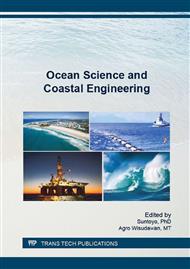p.78
p.83
p.90
p.96
p.102
p.107
p.115
p.121
p.127
Characteristics of Temperature and Salinity Distribution in the Wonorejo Estuary, Surabaya, Based on Field Measurement
Abstract:
Wonorejo waters have a significant value, both economically and socially. One of ecosystem that have close relationships with Wonorejo waters is Estuary. Temperature and salinity have role in water circulation, where the water circulation have impact to some organism distribution and pollutant dispersion. The purpose of this study is to investigate the characteristic of temperature and salinity distribution in Wonorejo Estuary body’s water. Furthermore, it can be used for determining the type of Wonorejo Estuary. The observation has been done at Wonorejo Estuary in August 2015 to measure the vertical and horizontal temperature and salinity distribution. The measurement of temperature and salinity used Conductivity, Salinity, Temperature tool by YSI. The result show that commonly the temperature and salinity vertical profile are almost similar from surface layer until the bottom layer. But they have trend where the salinity increase, while the temperature decrease to the water depth. There is no thermocline layer due to the shallow water area, it is so from the upper layer until the bottom layer still influenced by dragforce and the vertical mixing between fresh water and sea water occurs. The horizontal temperature distribution in the open sea surface tend to zonation, which is not depend to longitudinal position. The salinity value in each depth are not change obviously indicate that there is a vertical well mixed between fresh water and sea water.
Info:
Periodical:
Pages:
102-106
Citation:
Online since:
January 2017
Authors:
Keywords:
Price:
Сopyright:
© 2017 Trans Tech Publications Ltd. All Rights Reserved
Share:
Citation:


